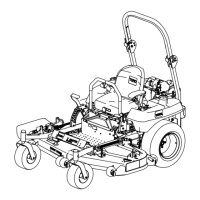Figure 69
1. Cutting Edge 3. Wear/slot Forming
2. Curved Area
2. Inspect the blades , especially the cur v ed area
( Figure 69 ).
If y ou notice any damag e , w ear , or a slot
for ming in this area ( Figure 69 ), immediately
install a new blade .
Checking for Bent Blades
1. R otate the blades until the ends face forw ard
and bac kw ard ( Figure 70 ). Measure from a
lev el surface to the cutting edg e , position A , of
the blades ( Figure 70 ). Note this dimension.
Figure 70
1. Measure here from blade
to hard surface
2. Position A
2. R otate the opposite ends of the blades forw ard.
3. Measure from a lev el surface to the cutting
edg e of the blades at the same position as in
ste p 1 abo v e .
T he difference betw een the dimensions
obtained in ste ps 1 and 2 m ust not ex ceed
1/8 inc h (3 mm). If this dimension ex ceeds
1/8 inc h (3 mm), the blade is bent and m ust
be re placed; refer to R emo ving the Blades and
Installing the Blades .
A blade that is bent or dama ged could
br eak apar t and could seriousl y injur e or
kill y ou or bystander s.
• Al w ays r eplace bent or dama ged
blade with a new blade.
• Nev er file or cr eate shar p notches in
the edges or surf aces of blade.
Removing the Blades
Blades m ust be re placed if a solid object is hit,
if the blade is out of balance or is bent. T o
ensure optim um perfor mance and contin ued
safety confor mance of the mac hine , use g en uine
T oro re placement blades . R e placement blades
made b y other man ufacturers ma y result in
non-confor mance with safety standards .
Contact with a shar p blade can cause serious
injur y .
W ear g lo v es or wrap shar p edges of the
blade with a ra g .
1. Hold the blade end using a rag or
thic kly-padded glo v e .
2. R emo v e the blade bolt, spring disk and blade
from the spindle shaft ( Figure 73 ).
52

